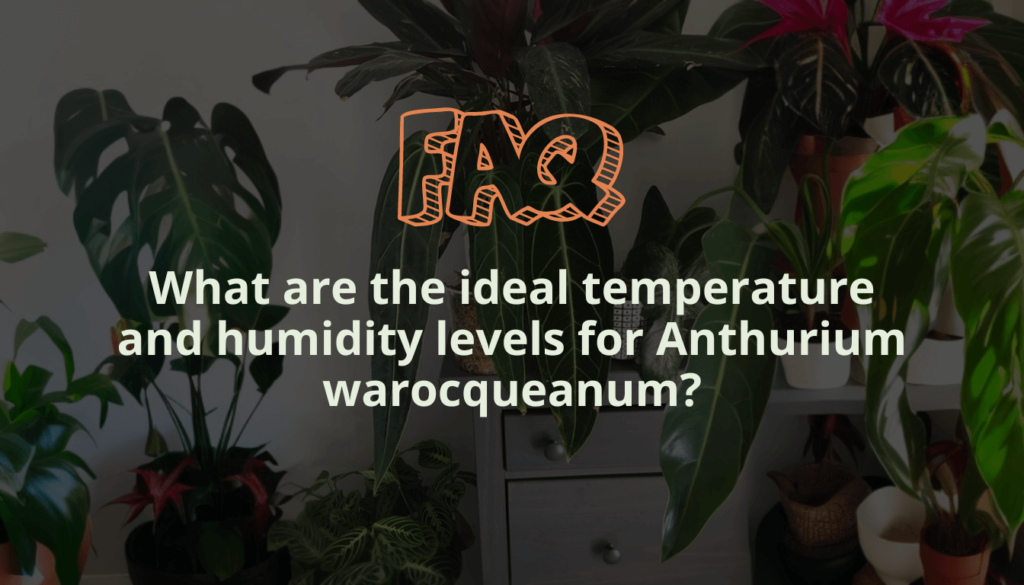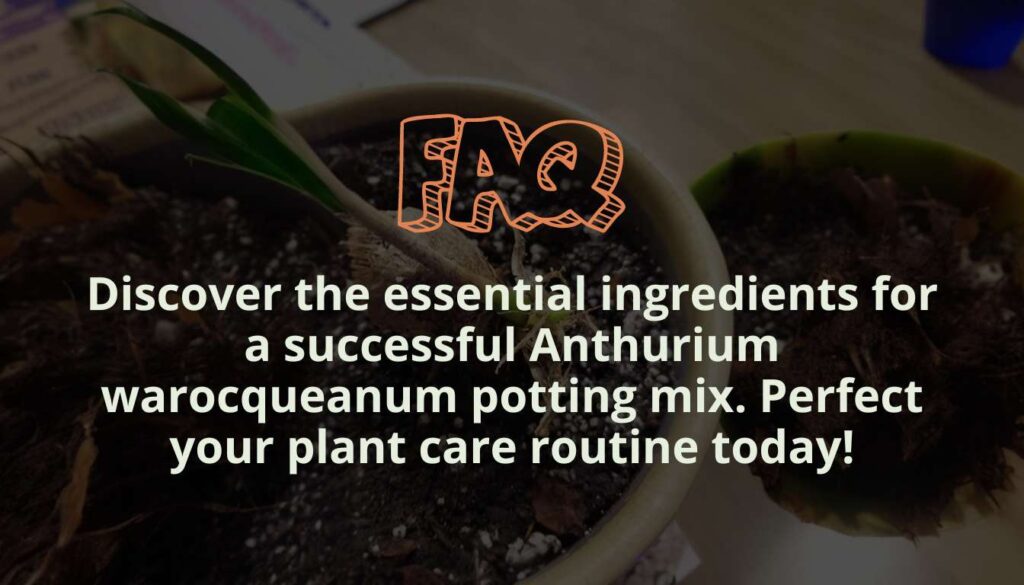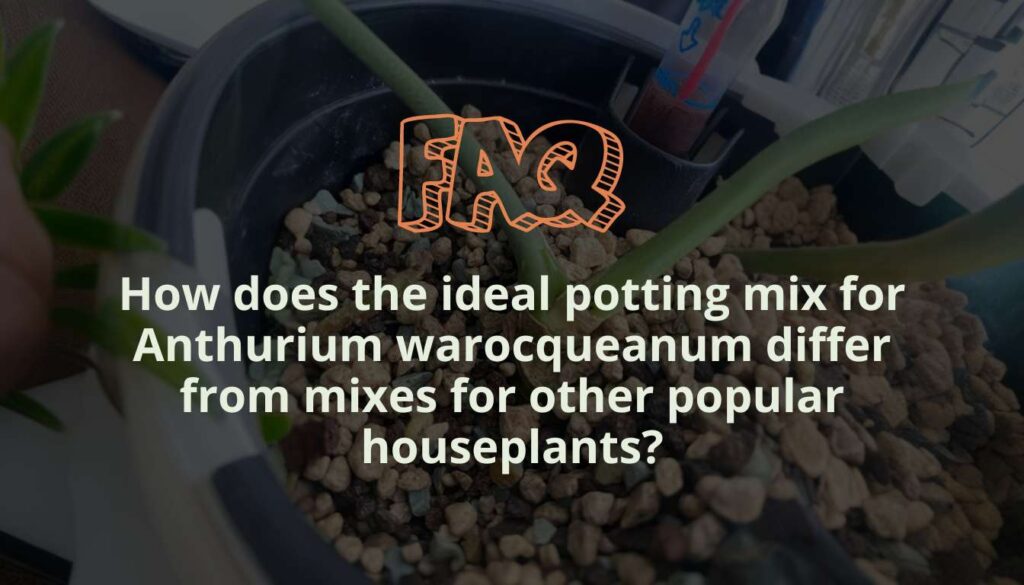Anthurium warocqueanum thrives in bright, indirect light. Here are some key points regarding its light requirements:
- Light Intensity:
- Provide bright, filtered light. Avoid exposing the plant to direct sunlight for extended periods, as this can scorch the leaves.
- Ideal locations include spaces with bright, indirect light, such as near a north or east-facing window where the plant receives filtered sunlight.
- Avoid Direct Sunlight:
- Anthurium warocqueanum is native to the understory of tropical forests, where it receives dappled sunlight. Therefore, it’s essential to protect it from direct sun, which can lead to leaf burn.
- Low-Light Tolerance:
- While it prefers bright, indirect light, Anthurium warocqueanum can tolerate lower light conditions. However, it may not thrive or produce as many flowers in low-light settings.
In summary, place Anthurium warocqueanum in a location with bright, indirect light to promote healthy growth and flowering, and be cautious not to expose it to direct sunlight for prolonged periods.
Specific to light requirements:
What are the signs my Anthurium warocqueanum is getting too much or too little light?
(Identifying the signs early can help you adjust the lighting situation.)
Here are signs indicating whether your Anthurium warocqueanum is getting too much or too little light:
Too Much Light:
- Leaf Scorching: If the plant is exposed to direct sunlight or too much bright light, you may notice brown, crispy edges on the leaves, indicating sunburn.
- Faded Leaf Color: The leaves may become pale or develop a bleached appearance if the light intensity is too high.
- Leaf Curling: Excessive light can lead to the curling of leaves as a protective mechanism to reduce surface area exposed to intense light.
Too Little Light:
- Leggy Growth: If the plant is not receiving enough light, it may exhibit stretched or leggy growth as it reaches for light sources.
- Dark Green Leaves: In low-light conditions, the leaves may become dark green, losing the glossy or vibrant appearance that healthy Anthurium warocqueanum leaves typically have.
- Reduced Flowering: Insufficient light can result in fewer flowers or a lack of flowering altogether.
Observing these signs can help you make adjustments to the lighting conditions promptly, ensuring that your Anthurium warocqueanum receives the optimal amount of light for its well-being.
Can Anthurium warocqueanum handle any direct sunlight? If so, how much and at what time of day?
(Understanding the plant’s tolerance can help you decide on the best window placement.)
While Anthurium warocqueanum prefers bright, indirect light, it can tolerate some direct sunlight under certain conditions. Here are guidelines for exposing Anthurium warocqueanum to direct sunlight:
- Filtered Morning Sunlight:
- The plant can tolerate gentle, filtered morning sunlight. Placing it in an east-facing window where it receives the softer morning sun can be beneficial.
- Limited Indirect Sunlight:
- In regions with mild sunlight, the plant may tolerate a brief period of indirect sunlight. However, it’s crucial to avoid prolonged exposure, especially during the intense midday and afternoon sun.
- Avoid Harsh Midday and Afternoon Sun:
- Anthurium warocqueanum should be protected from direct sunlight during the harsh midday and afternoon hours, as intense sunlight can lead to leaf burn.
- Use Sheer Curtains or Filters:
- If you have to place the plant in a location with more direct sunlight, consider using sheer curtains or other filters to diffuse and reduce the intensity of sunlight.
In summary, while Anthurium warocqueanum can handle some direct sunlight, it’s essential to provide protection during the intense midday and afternoon sun. Morning sunlight or filtered light is generally better tolerated. Adjusting the placement and using light filters can help create an optimal environment for the plant.
Are there different light requirements for the “dark form” and “light form” of Anthurium warocqueanum?
(Knowing potential differences can ensure each form receives optimal light.)
The “dark form” and “light form” of Anthurium warocqueanum refer to variations in the coloration of the leaves rather than differences in their light requirements. Both forms have similar light preferences. Here are general guidelines for providing light to both forms:
- Bright, Indirect Light:
- Both dark and light forms of Anthurium warocqueanum thrive in bright, indirect light. This typically involves placing the plant in a location where it receives filtered sunlight or in a bright room without direct exposure to the sun’s rays.
- Avoid Direct Sunlight:
- Protect both forms from prolonged exposure to direct sunlight, as this can lead to leaf burn and damage.
- Morning Sun or Filtered Light:
- The plant can tolerate gentle morning sunlight or filtered light. Placing it in an east-facing window or using sheer curtains to diffuse sunlight is beneficial.
- Consistent Lighting:
- While there may be subtle differences in leaf coloration between the dark and light forms, their overall care requirements, including light, are similar. Consistency in providing optimal light conditions is key to their well-being.
In summary, whether you have the “dark form” or “light form” of Anthurium warocqueanum, providing bright, indirect light and protecting the plant from direct sunlight remains important for both variants.
Alternatives to direct/indirect labels
How many hours of bright light does an Anthurium warocqueanum need per day?
(This can be a more precise way to measure light needs.)
Anthurium warocqueanum generally benefits from about 6 to 8 hours of bright, indirect light per day. This duration provides the plant with the energy it needs for photosynthesis and promotes healthy growth. It’s important to note that while the plant prefers bright light, it should be protected from prolonged exposure to direct sunlight to prevent leaf burn. Adjusting the placement of the plant or using sheer curtains to filter light can help achieve the optimal balance of brightness without the risk of scorching the leaves.
What type of artificial lighting can I use to supplement natural light for my Anthurium warocqueanum?
(This could be helpful if you don’t have ideal window placement.)
If you don’t have ideal natural light conditions, you can supplement light for your Anthurium warocqueanum using artificial lighting. Here are some recommendations:
- LED Grow Lights:
- LED grow lights are energy-efficient and emit a spectrum of light that closely mimics natural sunlight. Choose a full-spectrum LED grow light to provide the necessary light wavelengths for plant growth.
- Fluorescent Lights:
- Fluorescent lights, particularly T5 or T8 fixtures with a cool or warm spectrum, can be suitable for Anthurium warocqueanum. Position the lights close to the plant to ensure adequate light intensity.
- Adjustable Light Stands:
- Consider using adjustable light stands or fixtures to customize the height and angle of the artificial light, providing even coverage to the plant.
- Duration and Timing:
- Aim for 12 to 16 hours of artificial light per day to supplement natural light. Consistency in the lighting schedule is crucial for the plant’s growth.
- Monitor Intensity:
- Regularly check the light intensity received by the plant. If using artificial lights, make sure they provide sufficient brightness without causing heat stress or scorching.
When supplementing natural light with artificial lighting, it’s essential to monitor the plant’s response and adjust the setup as needed. Artificial lighting can be a valuable solution for maintaining optimal light conditions, especially in indoor environments with limited access to natural sunlight.
Is it okay to rotate my Anthurium warocqueanum to ensure even light distribution?
(Understanding the pros and cons can help you decide if this is necessary.)
Yes, rotating your Anthurium warocqueanum is a good practice to ensure even light distribution, and it comes with several benefits:
Pros:
- Even Growth: Rotating the plant regularly promotes even growth on all sides, preventing it from leaning or reaching towards a light source.
- Balanced Foliage Development: Turning the plant helps in achieving balanced foliage development, preventing one side from becoming denser than the other.
- Equal Exposure to Light: By rotating, different parts of the plant receive equal exposure to light, which is important for maintaining overall health and preventing uneven coloration or sunburn.
- Encourages Symmetry: Regular rotation encourages a more symmetrical and aesthetically pleasing appearance.
Cons:
- Adjustment Period: Sudden changes in light direction can lead to an adjustment period for the plant. If rotating, do so gradually to allow the plant to acclimate.
- Disruption of Flowers or Buds: If the plant is in bloom, rotating it may disrupt flowers or buds. Consider the flowering stage when deciding the frequency of rotation.
In summary, rotating your Anthurium warocqueanum is generally beneficial for promoting even growth and preventing issues related to uneven light exposure. Be mindful of potential adjustments the plant may need and consider the flowering stage when implementing rotation.
Comparisons
How does the light requirement of Anthurium warocqueanum compare to other popular houseplants?
(This can help you determine if its light needs fit your existing environment.)
Anthurium warocqueanum’s light requirements are similar to many other popular houseplants that thrive in bright, indirect light. Here’s a comparison with some common houseplants:
- Snake Plant (Sansevieria):
- Similar Light Requirement: Snake plants also prefer indirect light but can tolerate lower light conditions.
- ZZ Plant (Zamioculcas zamiifolia):
- Similar Light Requirement: ZZ plants are adaptable and can thrive in low to bright, indirect light.
- Pothos (Epipremnum aureum):
- Similar Light Requirement: Pothos is versatile and can do well in a range of light conditions, including low to bright, indirect light.
- Spider Plant (Chlorophytum comosum):
- Similar Light Requirement: Spider plants prefer bright, indirect light but can tolerate lower light levels.
- Peace Lily (Spathiphyllum):
- Similar Light Requirement: Peace lilies thrive in bright, indirect light but can tolerate lower light conditions.
- Fiddle Leaf Fig (Ficus lyrata):
- Higher Light Requirement: Fiddle leaf figs prefer bright, indirect light and may require more intense light compared to Anthurium warocqueanum.
- Snake Plant (Sansevieria):
- Similar Light Requirement: Snake plants also prefer indirect light but can tolerate lower light conditions.
In general, Anthurium warocqueanum falls into the category of houseplants that thrive in bright, indirect light. However, it’s essential to consider the specific needs of each plant and make adjustments based on the lighting conditions available in your environment.
Are there any specific window directions best suited for Anthurium warocqueanum based on its light needs?
(Knowing ideal placements can simplify your care routine.)
Yes, for Anthurium warocqueanum, the ideal window directions are those that provide bright, indirect light without exposing the plant to harsh, direct sunlight. Here are some recommendations:
- East-Facing Window:
- Placing your Anthurium warocqueanum near an east-facing window is often ideal. This orientation allows the plant to receive the gentle morning sunlight, which is bright but less intense than the afternoon sun.
- North-Facing Window:
- North-facing windows can also be suitable, especially if they provide filtered or indirect light throughout the day. Anthurium warocqueanum can thrive in the consistent, moderate light from a north-facing window.
- Filtered Southern or Western Exposure:
- If placing the plant near a southern or western window, ensure that it receives filtered sunlight or is positioned away from direct sun rays. Using sheer curtains or placing the plant at a distance from the window can help prevent leaf burn.
- Avoid Strong Western Sun:
- Be cautious about placing Anthurium warocqueanum directly in the path of intense western sunlight, especially during the afternoon. If exposed to strong western sun, ensure that the plant is protected by sheer curtains or is positioned further from the window.
By considering these window directions and taking measures to filter or diffuse direct sunlight, you can create an optimal environment for Anthurium warocqueanum, ensuring it receives the right balance of brightness without the risk of leaf damage.
How does the light requirement of the “dark form” differ from the “light form” of Anthurium warocqueanum?
(Understanding these differences can ensure optimal light for each form.)
The light requirements for the “dark form” and “light form” of Anthurium warocqueanum are generally similar, as both variations belong to the same species and share comparable care needs. Here are some considerations:
- Bright, Indirect Light:
- Both the dark and light forms of Anthurium warocqueanum prefer bright, indirect light. This typically involves placing them in locations where they receive filtered sunlight or in bright rooms without direct exposure to intense sunlight.
- Avoid Direct Sunlight:
- Protect both forms from prolonged exposure to direct sunlight, as this can lead to leaf burn and damage. Both variants benefit from protection against harsh midday and afternoon sun.
- Filtered Morning Sunlight:
- Both forms can tolerate gentle, filtered morning sunlight. Placing them in an east-facing window or providing filtered light in the morning is beneficial.
While there may be subtle differences in leaf coloration between the dark and light forms, their overall light requirements and care practices remain similar. Providing bright, indirect light and protecting them from direct sunlight are key considerations for both variations of Anthurium warocqueanum.
General care
How does light impact the growth and flowering of Anthurium warocqueanum?
(Knowing the connection can help you optimize light for desired outcomes.)
Light plays a crucial role in the growth and flowering of Anthurium warocqueanum. Here’s how light impacts these aspects of the plant’s development:
- Growth:
- Optimal Growth: Anthurium warocqueanum exhibits optimal growth when provided with bright, indirect light. Adequate light is essential for photosynthesis, the process by which plants convert light into energy for growth.
- Even Distribution: Ensuring even light distribution by rotating the plant periodically promotes balanced growth on all sides and prevents the plant from leaning or becoming lopsided.
- Flowering:
- Light as a Trigger: Light is a crucial factor in inducing flowering in Anthurium warocqueanum. Adequate light, especially bright, indirect light, signals to the plant that it is in a favorable environment for flowering.
- Balancing Light and Temperature: While light is important, a balance of both light and temperature is often necessary for consistent flowering. Maintaining the recommended temperature range alongside appropriate light conditions supports the production of flowers.
- Avoiding Direct Sunlight:
- Preventing Leaf Burn: Direct sunlight, especially during the intense midday and afternoon hours, can lead to leaf burn. Protecting the plant from direct sun exposure ensures that the leaves remain healthy and intact.
In summary, providing Anthurium warocqueanum with bright, indirect light is essential for its overall health, growth, and the induction of flowering. By maintaining optimal light conditions, you can encourage robust growth and enhance the likelihood of the plant producing beautiful flowers.
What are some common mistakes people make regarding light and Anthurium warocqueanum care?
(Learning from others can help you avoid them.)
Common mistakes people make regarding light and Anthurium warocqueanum care include:
- Exposing to Direct Sunlight:
- Mistake: Placing Anthurium warocqueanum in direct sunlight, especially during the harsh midday and afternoon hours.
- Solution: Provide bright, indirect light and protect the plant from direct sun exposure to prevent leaf burn.
- Inadequate Light:
- Mistake: Keeping the plant in low-light conditions for extended periods.
- Solution: Ensure Anthurium warocqueanum receives sufficient bright, indirect light to promote healthy growth and flowering.
- Ignoring Rotation:
- Mistake: Neglecting to rotate the plant regularly to ensure even light distribution.
- Solution: Rotate the plant periodically to promote balanced growth on all sides and prevent leaning.
- Overlooking Light Changes:
- Mistake: Making sudden changes in light conditions without allowing the plant to acclimate.
- Solution: Gradually introduce changes in light, especially when moving the plant to a new location or adjusting artificial lighting.
- Not Monitoring Light Intensity:
- Mistake: Failing to monitor the intensity of artificial lighting or sunlight received by the plant.
- Solution: Regularly check the light intensity and make adjustments to maintain optimal conditions.
By avoiding these common mistakes, you can provide the right light conditions for Anthurium warocqueanum, promoting its overall health, growth, and the likelihood of flowering.
What are some creative ways to provide Anthurium warocqueanum with the right amount of light?
(This can be helpful if your natural light options are limited.)
Certainly! Here are some creative ways to provide Anthurium warocqueanum with the right amount of light, especially if your natural light options are limited:
- Use Grow Lights:
- Creative Approach: Incorporate full-spectrum LED grow lights to simulate natural sunlight.
- Benefits: This is especially useful in spaces with limited access to natural light or during seasons with reduced sunlight.
- Mobile Plant Stand:
- Creative Approach: Use a mobile plant stand to easily move the Anthurium to different locations for optimal light exposure.
- Benefits: Allows you to experiment with different light conditions and find the best spot for your plant.
- Mirrors or Reflective Surfaces:
- Creative Approach: Place mirrors or reflective surfaces strategically to bounce and amplify available light towards the plant.
- Benefits: Enhances the brightness in the environment, especially in areas with lower natural light.
- Light Shelf or Display:
- Creative Approach: Create a dedicated light shelf or display using adjustable LED strips or grow lights.
- Benefits: Provides a controlled and customizable light source for the plant, optimizing its exposure.
- Rotating Plant Stands:
- Creative Approach: Use rotating plant stands to ensure even light distribution by periodically turning the plant.
- Benefits: Promotes balanced growth and prevents the plant from leaning towards a single light source.
- Clever Arrangement with Other Plants:
- Creative Approach: Arrange other plants strategically around the Anthurium to filter and diffuse light.
- Benefits: Creates a microclimate with diffused light, benefiting all plants in the arrangement.
By getting creative with these approaches, you can optimize the light conditions for Anthurium warocqueanum, even in spaces where natural light may be limited.




